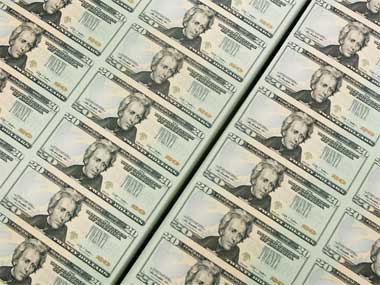The benchmark US equity index the Dow Jones Industrial Average (Dow) closed at all time highs on 5 March 2013. The Dow crossed the earlier high recorded in the year 2007 to close at levels of 14253. The Dow has gained over 8.5% calendar year to date and the record close on 5th March indicate further gains ahead.
The record close of the Dow on 5 March, 2013 was not expected as the US government cut back spending by $85 billion starting 1 March, 2013. The spending cuts known as the “Sequester” was seen as negative for the US economy that showed an annual growth rate of just 0.1% in the fourth quarter of 2012. The fact that US equities shrugged off the spending cuts suggests that US markets are hopeful of strong corporate performance on the back of a recovering economy.
[caption id=“attachment_650353” align=“alignleft” width=“380”] The US economy is on a path to recovery and that is being reflected in the record close of the Dow. Getty Images[/caption]
US economic data has largely been positive with data showing improvement in home sales, consumer confidence, service indices and retail sales. US January 2013 pending home sales rose to its highest levels since April 2010. The record low policy rates of the US Federal Reserve (Fed), which is between 0% and .25%, and the bond purchase programme of the Fed, which is buying $85 biilion of bonds a month, is feeding into low mortgage rates. US mortgage rates are close to record lows and this coupled with property prices that are just coming out of a slump is helping prospective home owners in the country.
Retail sales in the US rose for the third straight month in January 2013 suggesting that consumers are spending despite worries on the economy. US consumer confidence showed strength in February and this bodes well for consumer spending. US service sector activity expanded for the 38th consecutive month in February with the ISM non manufacturing purchasing managers index printing at levels of 56 against levels of 55.2 seen in January. The sustained rise in the US service sector index that covers 90% of the economy is highly positive for the economy.
The US economy is on a path to recovery and that is being reflected in the record close of the Dow.
How should you look at your investments now?
Economic growth in the world’s largest economy will have ripple effects on economies across the globe. In a globalized world, the performance of the US economy is of high significance especially at a time when fast growing economies of China and India are slowing down. China has adopted a growth rate of 7.5% for 2013 indicating that the country is now looking at quality growth rather than quantity growth. India has forecast a growth rate of 6.5% for 2013-14 and the country has its own problems of high fiscal and current account deficits that are hurting the economy.
The loose monetary policy adopted by the Fed is helping keep global liquidity high and this liquidity tends to find its way into economies like India that show promise despite on going issues. India also has one of the highest interest rate regimes in the world and the spread between Indian and US policy rate is 7.5%. The wide interest rate differential helps attract interest rate arbitrage flows to the country and this capital flows go to negate a high current account deficit that is running at close to $80 billion.
The global market risk measures of credit spreads and VIX are also showing low risk aversion trends. Credit spreads as measured by CDS (Credit Default Swaps) levels on emerging market credits are trading at five-year lows. The yield on the benchmark five and ten year ICICI Bank USD bond is down 100bps over the last one year. The benchmark CBOE (Chicago Board Options Exchange) volatility index (VIX) that measures the expected market volatility from the S&P 500 index option prices is trading at a one year low.
The low readings of risk aversion measures suggest that global investors have good risk appetite at present. There is no fear amongst investors and that is good for Indian Rupee, bonds and equities. The Rupee will trade more on fundamentals while equities and bonds will reflect the growing risk appetite amongst global investors. Hence outlook for INR is not negative but not very positive either given weak domestic fundamentals and broad USD strength globally while outlook for the Sensex, Nifty and ten year government bond is positive.
Position your investment accordingly.
Arjun Parthasarathy is the Editor of www.investorsareidiots.com a web site for investors


)
)
)
)
)
)
)
)
)



